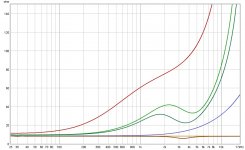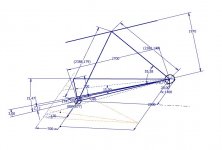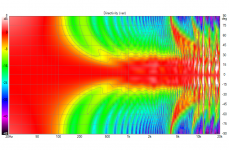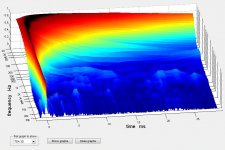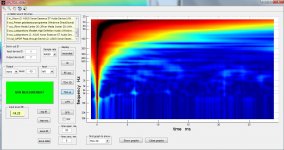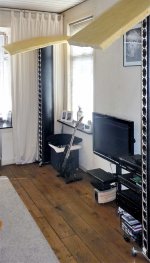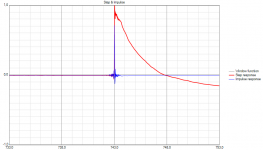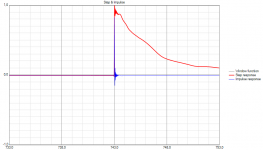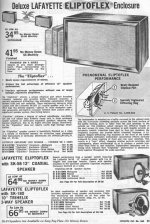Don't forget Maya and 3ds-max as quite capable mesh editors/modelers... 
Just finished installing the first two bypass filters to finish up all filters installment on the first array. Even though they are much smaller than the big series filters, they still are a pain to install into a finished cabinet! They are in though, time for a quick break and then some measurements to see if everything still checks out.
If it does, then the first array will be ready to close back up again. Which is an enormous job by itself (lol), trying to seal it all off properly.
A few weeks ago I said: I'm just going to close them back up and be done with it...
Funny how time always changes the plans. I'll first just mount the inner baffle holding all the drivers with a few spacers, so I can re-apply the finish on the outside of the enclosure. More work, more time without speakers, but I just know if I bring them back in again I'll never do said work (and just keep on listening). I still need the weather to work with me, as it did this weekend.
Fingers crossed!
Just finished installing the first two bypass filters to finish up all filters installment on the first array. Even though they are much smaller than the big series filters, they still are a pain to install into a finished cabinet! They are in though, time for a quick break and then some measurements to see if everything still checks out.
If it does, then the first array will be ready to close back up again. Which is an enormous job by itself (lol), trying to seal it all off properly.
A few weeks ago I said: I'm just going to close them back up and be done with it...
Funny how time always changes the plans. I'll first just mount the inner baffle holding all the drivers with a few spacers, so I can re-apply the finish on the outside of the enclosure. More work, more time without speakers, but I just know if I bring them back in again I'll never do said work (and just keep on listening). I still need the weather to work with me, as it did this weekend.
Fingers crossed!
Yeah! Control measurements done, all works out as expected!
5 sets of 5 driver positions tested with a straight wire instead of the driver and an 8 ohm (8.2 ohm give or take) resistor in series.
Bypass tested on the driver position with a parallel resistor (same 8.2 ohm).
This all checks out and resembles the needed curves:

All driver groups are visible, the straight line is the middle set of (5) drivers that don't have any filter at all. The one(s) with the 3.5 KHz dip are
2x bypass filter on one driver each. The rest of them are the filter blocks of each section, as figured out by Vituixcad sims.
So the next job will be to close this one up with the inner baffle and the drivers, checking to see if all drivers have sound. That will hopefully be a job for next weekend. If the weather permits... Then on to the next...
What would we do without (in no particular order):
John Mulcahy for giving us REW
Bill Waslo for bringing us X-Sim
Kimmo Saunisto for the awesome Vituixcad (which took me a while to spell right )
)
Denis Sbragion for creating DRC-FIR (which I will need to get it all back up again)
The DIYaudio forums and it's helpful and generous members...
Without the above, and many more which I no doubt forgot to mention I would never have got this far with my project.
A project that still is fun for me and new adventures keep coming. Keep sharing guys, I'll try and be as open as I can on
my part. Working together we can really achieve something special.
5 sets of 5 driver positions tested with a straight wire instead of the driver and an 8 ohm (8.2 ohm give or take) resistor in series.
Bypass tested on the driver position with a parallel resistor (same 8.2 ohm).
This all checks out and resembles the needed curves:
All driver groups are visible, the straight line is the middle set of (5) drivers that don't have any filter at all. The one(s) with the 3.5 KHz dip are
2x bypass filter on one driver each. The rest of them are the filter blocks of each section, as figured out by Vituixcad sims.
So the next job will be to close this one up with the inner baffle and the drivers, checking to see if all drivers have sound. That will hopefully be a job for next weekend. If the weather permits... Then on to the next...
What would we do without (in no particular order):
John Mulcahy for giving us REW
Bill Waslo for bringing us X-Sim
Kimmo Saunisto for the awesome Vituixcad (which took me a while to spell right
Denis Sbragion for creating DRC-FIR (which I will need to get it all back up again)
The DIYaudio forums and it's helpful and generous members...
Without the above, and many more which I no doubt forgot to mention I would never have got this far with my project.
A project that still is fun for me and new adventures keep coming. Keep sharing guys, I'll try and be as open as I can on
my part. Working together we can really achieve something special.
Attachments
Last edited:
Of course the above list of thank you's should also include Marcel Batík (mabat) for creating the ATH horn tools and Thomas Drugeon (pos) for handing us RePhase and many many more.
With the tools they offer (free for personal use) our community now has possibilities we could have only dreamed about having at our disposal. Combined with a wide variety of enthusiastic users, who may not always agree with each other, we do have a rather unique place here. With a wealth of information available if one cares to look for it.
Now I know I've only mentioned highly technical pieces of software and their generous creators, but its much more than that. We have all kinds of people here that have something to bring to the table. In my humble opinion that's whats needed to continue to be innovative, tickle our curiosity etc. Most of the ideas I've chased here (in this thread) were triggered by something someone wrote (most often somewhere on this forum)...
Lots of the basic concepts I've picked up just reading along on lots of different topics. And I still do read more than I type, amazing isn't it? I know I do tend to type a lot!
I know I do tend to type a lot! 
I'm almost as exited about this latest project (the added filters) as when I was building the arrays and firing them up for the first time.
Triggered by Jack (nc535) and his continuous curiosity into the workings of different speakers by simming the ... out of them.
Without seeing what he was doing, and finally understanding why he was doing it, I would never have gotten to this part. I've always been curious about the idea(*), but without a way of "seeing what can be done" (by sims like Vituixcad) it would have been just that... curiosity about an idea.
Anyway, to me this is a big thing. One heck of a reason for me to continue to try and participate here. You never know where it might lead us next!
No idea where this (above) all came from, you'll have to excuse me.
I do think is awesome to be part of a sharing community like we see here. And it keeps getting better...
(*) = the idea of creating a frequency dependent kind of shading, I never followed up on it before, because it was so hard to predict/envision what it would do out in the room. The continuously developing tool-set at our disposal has made all the difference.
[end of rant... I think ]
]
With the tools they offer (free for personal use) our community now has possibilities we could have only dreamed about having at our disposal. Combined with a wide variety of enthusiastic users, who may not always agree with each other, we do have a rather unique place here. With a wealth of information available if one cares to look for it.
Now I know I've only mentioned highly technical pieces of software and their generous creators, but its much more than that. We have all kinds of people here that have something to bring to the table. In my humble opinion that's whats needed to continue to be innovative, tickle our curiosity etc. Most of the ideas I've chased here (in this thread) were triggered by something someone wrote (most often somewhere on this forum)...
Lots of the basic concepts I've picked up just reading along on lots of different topics. And I still do read more than I type, amazing isn't it?
I'm almost as exited about this latest project (the added filters) as when I was building the arrays and firing them up for the first time.
Triggered by Jack (nc535) and his continuous curiosity into the workings of different speakers by simming the ... out of them.
Without seeing what he was doing, and finally understanding why he was doing it, I would never have gotten to this part. I've always been curious about the idea(*), but without a way of "seeing what can be done" (by sims like Vituixcad) it would have been just that... curiosity about an idea.
Anyway, to me this is a big thing. One heck of a reason for me to continue to try and participate here. You never know where it might lead us next!
No idea where this (above) all came from, you'll have to excuse me.
I do think is awesome to be part of a sharing community like we see here. And it keeps getting better...
(*) = the idea of creating a frequency dependent kind of shading, I never followed up on it before, because it was so hard to predict/envision what it would do out in the room. The continuously developing tool-set at our disposal has made all the difference.
[end of rant... I think
Last edited:
There is a lot of talk about DSP in this thread of mine... if anyone is lurking this thread, thinking about using some DSP, check out this interview with Mitch: The Intellectual People Podcast - Mitch Barnett of Accurate Sound (known on this forum as member mitchba).
When I was starting my own journey into DSP, I found a thread between Mitch, Bob Katz and Audiolense creator Bernt on the use of that software. That was like a crash-course for me to get up to speed about DSP software. Even though I was to use a different package, it really helped me to get a clear picture of what to expect etc. I've linked to that discussion at the time over here: https://www.diyaudio.com/forums/full-range/242171-towers-25-driver-range-line-array-72.html#post4168817 Even though a lot of time has passed, there's still some good info to be found there.
When I was starting my own journey into DSP, I found a thread between Mitch, Bob Katz and Audiolense creator Bernt on the use of that software. That was like a crash-course for me to get up to speed about DSP software. Even though I was to use a different package, it really helped me to get a clear picture of what to expect etc. I've linked to that discussion at the time over here: https://www.diyaudio.com/forums/full-range/242171-towers-25-driver-range-line-array-72.html#post4168817 Even though a lot of time has passed, there's still some good info to be found there.
Last edited:
So, I've got those "horns" to deal with, reflection wise...
I figured I needed to find out the travel time difference for the bounce to reach my listening spot. (done that many weeks ago actually)
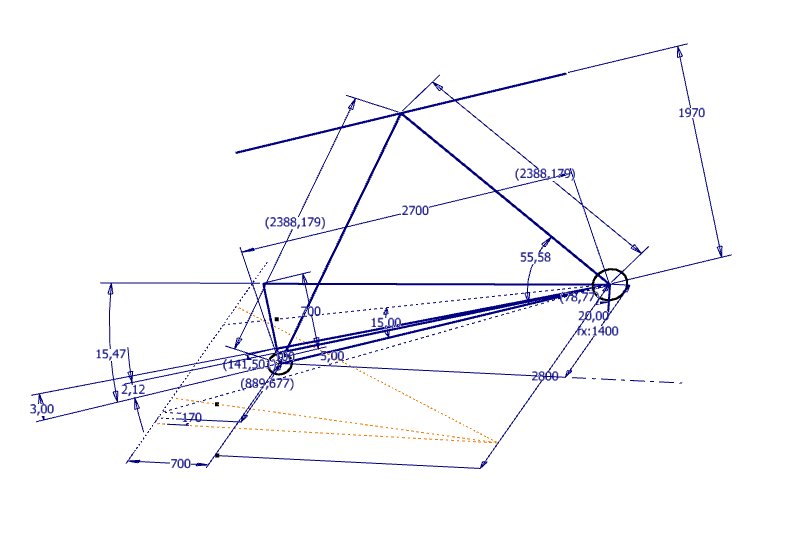
The difference in travel length was about 2.076 metre. Which is about a 6 ms delay. The one thing I did not do is look at one of many measurements made to see if I could find it there! Until late last night! I figured a bounce like that...

(unshaded sample with fluid's ABEC sim results)
... would have to show up somewhere, right? I can't imagine why that didn't go on any sooner...
didn't go on any sooner...
So late last night, I've checked some graphs, the first one I found was this:

APL_TDA plot from 2016
It was there all along... right in front of my eyes... see the bump at ~6ms? And at about 4-5 KHz? even some traces there of sooner action from the floor.

Duh.... now there's only one thing left for me to wish/hope for... I sure hope my new (renovated) ceiling won't reflect more than my previous aluminium ceiling that we removed during the last summer. The bounce was quite soft in energy, as seen in other graphs I've made trough the years, but it has always been there, right in front of my eyes... Before installing my damping panel/poster, the back wall kind of arrived at a similar timing and I've always blamed that bump to be a residu of that. (panel not being large enough or something like that)
I also looked at some other's array plots I've kept trough the years and sure enough it is there on them too.
Another view of my situation:
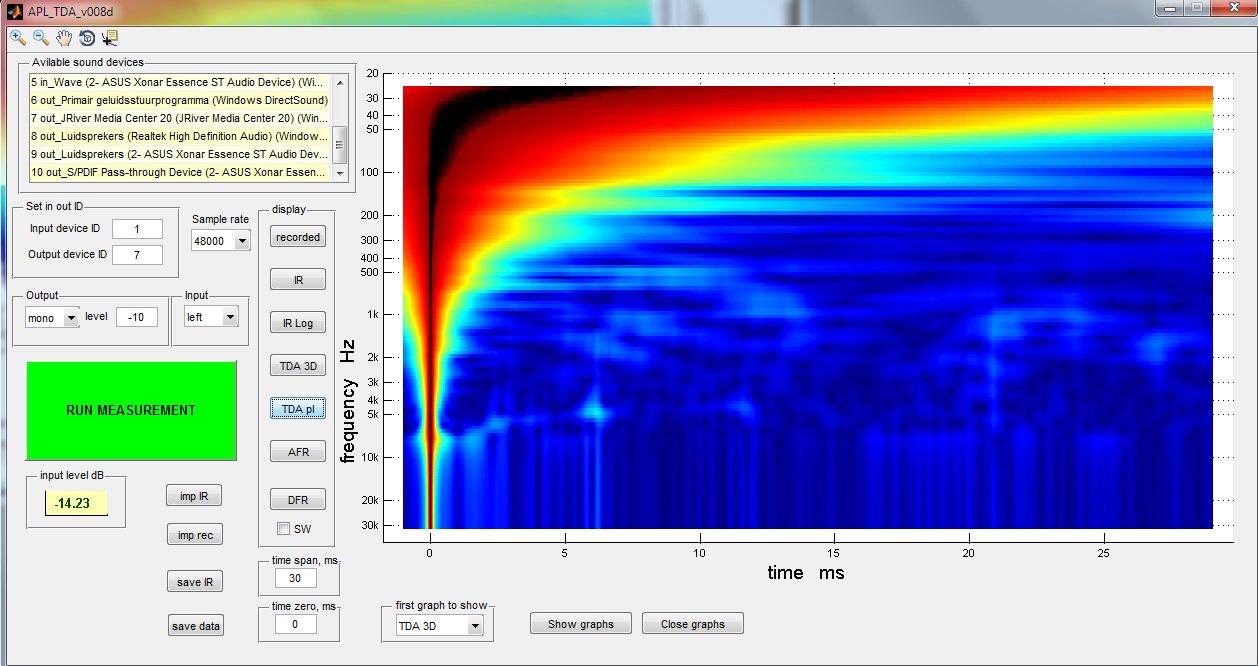
I figured I needed to find out the travel time difference for the bounce to reach my listening spot. (done that many weeks ago actually)
The difference in travel length was about 2.076 metre. Which is about a 6 ms delay. The one thing I did not do is look at one of many measurements made to see if I could find it there! Until late last night! I figured a bounce like that...
(unshaded sample with fluid's ABEC sim results)
... would have to show up somewhere, right? I can't imagine why that
 didn't go on any sooner...
didn't go on any sooner... So late last night, I've checked some graphs, the first one I found was this:
APL_TDA plot from 2016
It was there all along... right in front of my eyes... see the bump at ~6ms? And at about 4-5 KHz? even some traces there of sooner action from the floor.
Duh.... now there's only one thing left for me to wish/hope for... I sure hope my new (renovated) ceiling won't reflect more than my previous aluminium ceiling that we removed during the last summer. The bounce was quite soft in energy, as seen in other graphs I've made trough the years, but it has always been there, right in front of my eyes... Before installing my damping panel/poster, the back wall kind of arrived at a similar timing and I've always blamed that bump to be a residu of that. (panel not being large enough or something like that)
I also looked at some other's array plots I've kept trough the years and sure enough it is there on them too.
Another view of my situation:
Attachments
Last edited:
No work done on the array this weekend. As stated early on in this thread, my health isn't all that. So I determined it was a little too cold for me and I'll wait for better times.
I did manage to tidy up a DRC-FIR template to make it nice and clean and minimum phase. If any phase work is needed below ~200 Hz, I'll do it manually using RePhase.
That way I get to keep a cleaner IR, less ringing at high frequencies. Not that I've heard ringing, but trying to avoid it is even better (peace of mind).
If I let DRC-FIR do that job, it will also run up to higher frequencies or it will still create more 'haze" (at low SPL) at higher frequencies. Having the correction minimum phase throughout prevents that. It is what I used on my last corrections but the template could use a little work as it wasn't meant for 100% minimum phase yet.
Basically the difference between an impulse like this:
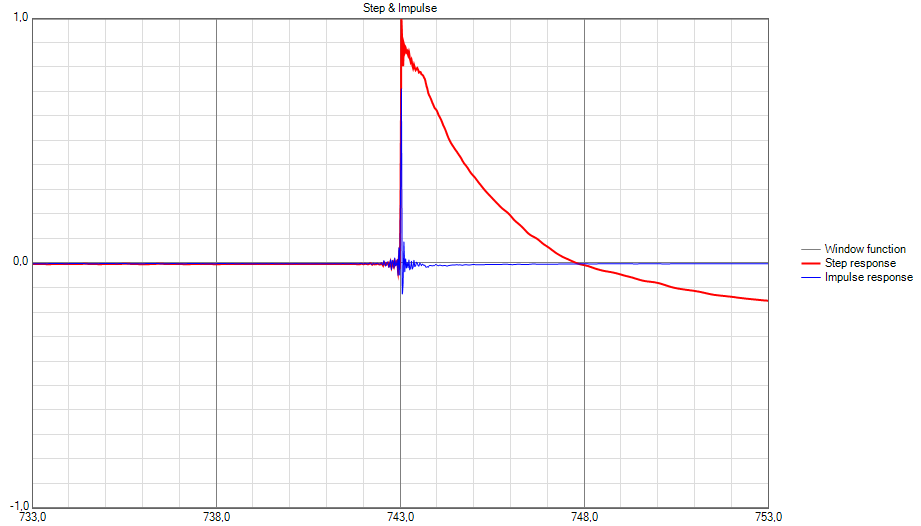
and
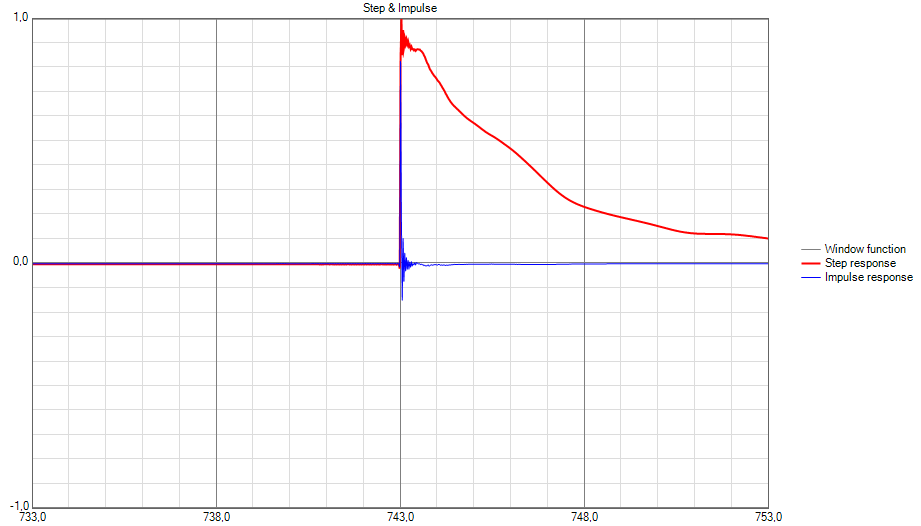
(both of them are Vituixcad simulations with DRC-FIR correction)
I did manage to tidy up a DRC-FIR template to make it nice and clean and minimum phase. If any phase work is needed below ~200 Hz, I'll do it manually using RePhase.
That way I get to keep a cleaner IR, less ringing at high frequencies. Not that I've heard ringing, but trying to avoid it is even better (peace of mind).
If I let DRC-FIR do that job, it will also run up to higher frequencies or it will still create more 'haze" (at low SPL) at higher frequencies. Having the correction minimum phase throughout prevents that. It is what I used on my last corrections but the template could use a little work as it wasn't meant for 100% minimum phase yet.
Basically the difference between an impulse like this:
and
(both of them are Vituixcad simulations with DRC-FIR correction)
Attachments
Fluid those are floor reflections isn't it?
Wesayso, well spoted! There is same thing with mtm: the bigger the driver ( hence the lower the freq where it happen) the more offending it may be as it'll happen in more troublesome freq range.
In a way you are lucky as the freq at which it happen in your case could be held undercontrol more easily than with big mtm ( 15" drivers). Either absorption or diffusor could help greatly if located at the right spot ( you won't need to cover the whole ceilling).
Could even be very discreet:
Akustar - diffuseur de Schroeder Skyfusor
And not be this ugly ( as your overall style is modern it could be easier for your half to accept it!).
Wesayso, well spoted! There is same thing with mtm: the bigger the driver ( hence the lower the freq where it happen) the more offending it may be as it'll happen in more troublesome freq range.
In a way you are lucky as the freq at which it happen in your case could be held undercontrol more easily than with big mtm ( 15" drivers). Either absorption or diffusor could help greatly if located at the right spot ( you won't need to cover the whole ceilling).
Could even be very discreet:
Akustar - diffuseur de Schroeder Skyfusor
And not be this ugly ( as your overall style is modern it could be easier for your half to accept it!).
Last edited:
It doesn't come from the ceiling, this is where it was measured.Fluid those are floor reflections isn't it?
Wesayso, well spoted! There is same thing with mtm: the bigger the driver ( hence the lower the freq where it happen) the more offending it may be as it'll happen in more troublesome freq range.
In a way you are lucky as the freq at which it happen in your case could be held undercontrol more easily than with big mtm ( 15" drivers). Either absorption or diffusor could help greatly if located at the right spot ( you won't need to cover the whole ceilling).
Could even be very discreet:
Akustar - diffuseur de Schroeder Skyfusor
And not be this ugly ( as your overall style is modern it could be easier for your half to accept it!).
I'll have to see what it does with our new ceiling. Gone is the slightly lower 920cm) metal ceiling. It hasn't been a disruptive reflection at about 6ms, meaning the direct sound is quite a bit louder and the later reflection does not create an imbalance in the perceived frequency response (averages to the same FR curve). Hanging something from the ceiling will not be an option. If I read my sims right, the spray towards the ceiling has been reduced with the addition of the new filters. The new ceiling (height close to 3 m) is an unknown variable, but if it is similar as before, or with luck any lower in amplitude I'll gladly accept it for what it is.
If I can come up with a clever way to reduce it even further by coming up with clever new baffle geometry (in due time) I might consider such a move.
That's what the sims fluid ran were all about, it would be possible to win some. First i need to establish what I have with both the filters + renovated living room. Normally I only change one variable at a time. When the arrays move back in, more than one thing will be different, meaning I'll start over to find out what it does for perception etc.
I'm quite hopeful it will be a move forward, on more than one count. My patience will be tested though, due to our global change I won't have the luxury I had, having the house to myself on set times. Who knows what the near future will bring, until then I'll try and finish what I have planned and won't make any new plans till that part is done.
Which is why I haven't started with ABEC sims yet, as it would distract me from realizing these earlier goals.
After getting the arrays back in action and re-reading the room I have now I still have to finish my 6 channel pré-amp. Enough on the plate for the near future. Lots of ideas of things to try with the ambient channels etc.
All in due time... looking forward to it though. I thought what I had was awesome. If it can be just a little bit better, if some improvement could be found? As long as it's fun I'll carry on
perhaps the deflecting "lips" of the old Lafayette "Eliptoflex" (R-J variant) had some merit
https://patentimages.storage.googleapis.com/ff/4d/7f/7f33ab6545438a/US3089562.pdf
https://patentimages.storage.googleapis.com/ff/4d/7f/7f33ab6545438a/US3089562.pdf
Attachments
We've already seen a positive change with only a minor lip between the vertical drivers, see: https://www.diyaudio.com/forums/full-range/242171-towers-25-driver-range-line-array-667.html#post6542350
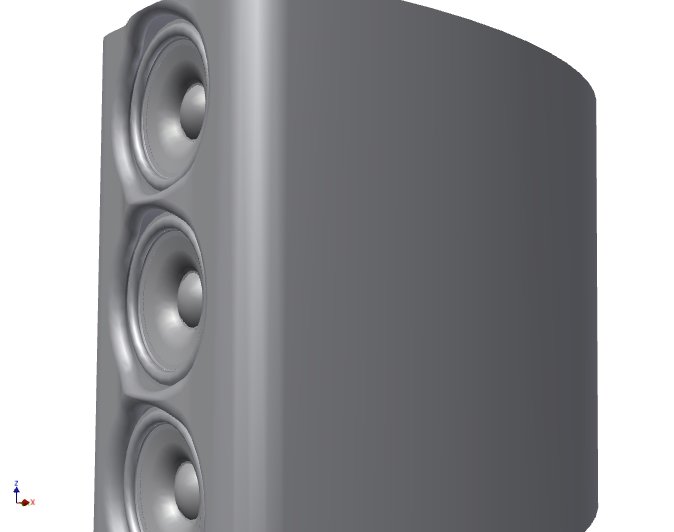
@troystg, a smart choice! Giving you options down the road!
@ericspt, I did see your thread and the mention of line arrays, both straight and CBT shaped arrays were mentioned.
Sorry that this thread became as long as it did. But there's lots of good info in it, both on what to do and what not to do
.
There were a couple of warnings that came along with straight arrays like I have here. You need EQ! That's not negotiable. Preferably the FIR kind, as that gives you a lot of power to adjust these to your liking.
I haven't shared the templates I used. At some point I did consider making and selling speakers, but I don't see it happening. The shape can be reproduced though from all drawings and pictures I posted. I'm still a bit reluctant to share them. You should think long and hard if you want to build stacked arrays like I did. You'd need to do something to prevent what happened to me, a cracked enclosure due to seasonal changes. I have been successful to repair it and prevent it from happening again, but you'd need to be a little crazy to build it like that.
I wouldn't want a segmented baffle. The drivers are mounted as close as possible (center to center) and there simply isn't much room to make sure everything is sealed properly.
On the driver front? I did not get the driver I used based on price. I based it on the published results in many tests etc, it is a marvelous driver. You'll find some other opinions, no doubt, but I wouldn't hesitate one moment to use it again. An upgrade could be the TG9 FD10-08, but I haven't seen them in stock lately, you can get them in quantities of 2000 though.
The 4 ohm sister to that one (TG9 FD10-04) is more easily available, but I'm not quite sure it is performing as good.
Another, way more pricey option would be the Scan Speak 10F, in an 8 ohm shape. There are a few versions, some of them have a closed off spider which wouldn't be ideal (if you want to make bass with them). Plus the driver has a circular frame which needs to be "shaved" to get the drivers closer together.
The TC9 simply is an honest, well designed driver and it looks like it was made for this job. In your relatively large room I'd advise using subs for the bottom end. I could do without easily in my ~8 meter x 4 meter room, but others with bigger rooms were less lucky/successful. I'd aim for a 2 litre to 2.2 litre enclosure for each driver.
I've picked this driver/size to be able to get a full range sound out of a single (well, 25 of them) driver. An array with crossovers is simply going to be a different beast. And quite honestly, I don't think I'm going there, at least not unless we'd find a way to keep all that is good in this full range type of array.
This driver size is the biggest I would consider for this job. You need a special combination, clean performance (no ringing up top) and enough x-max. Check out the different line arrays by Halair, fluid, nc535, koldby, OPC and many more that I forgot to mention.
In my humble opinion, there is a lot to like about these arrays, and I do believe part of it is the absence of a crossover.
While I'm currently playing with filters etc, that is just curiosity driven. It may make things better, but sometimes I do wonder why I even try. This speaker has been more than satisfying for over 5 years of use.
There simply is more to learn, and that's part of this crazy hobby for some of us.
Do think it trough, most important: how will you solve the needed EQ?
I have a PC Workstation that does that part for me, with a lot of handy programs. But it isn't for everyone. My other half does not dare turn on my system (not that I'm sad about that). My son has no problems with it though.
You could do the EQ with other tools, but a PC is one heck of a tool to play with. As a former IT professional it was an obvious choice for me. As that allowed me to make it into my own personal play-garden. The PC is running all audio tasks, doubles as my Home Theater server and is the heart of 6 channels of audio, steering the two main arrays, the subwoofers and 2 ambient channels. I still have 2 more channels available should I ever get bored.
As I'm a bit long winded in my response already I'll stop here to not overload you with information. Feel free to ask more questions though. I'll help where I can if you decide to go this route. And there are other generous members with arrays that I'm sure would chime in as well.
Plan it good, it might just be the last speaker you'll ever need! Did you see the links in the first post of this thread? That's an easy way to navigate through the enormous amount of info, and there are some reviews by a few visitors, which should provide some idea of what to expect.
You wanted a project for you and your wife, right? Well... this sure would give you something to do!
**edit** the driver mark100 mentioned, that are used in Jim's CBT's sure are another good option. more expensive, but they can be mounted closer together which is an advantage. They won't do the bottom octaves, you'd definitely need subwoofers. (preferably more than one to keep up)
Check out nc535's thread as he used the same driver in his corner arrays.
As subwoofers would be advised in a larger room anyway, it sure could be another valid option.
Sorry for the long quote but it contains all I would like to respond to. I'm seriously thinking of building this excellent set of speakers 'to end them all'.
I have built a few in my life and owned a few others. noticeably BW's and Kef RR105s. I know what I find really important (as perfect as possible reproduction of solo piano, female voices, cellos), what is crucial in speakers (spatial and uncompressed orchestras, 'live' sound of f.i. guitar strings).
I have had speakers excelling in some, but not all of the above. I have experimented with full range speakers and they solve some important issues in phase / time coherency to my liking.The lack of analog filters was helpful for transients / responsiveness / coherency, which all translated in imaging and realistic instrument reproduction.
The only common problem of all speakers were the room dependencies. Speakers which performed excellent didn't survive a move to a new living room. The commercial speakers always fared better but never excelled my best DIY efforts in optimum acoustic environments. I am now convinced that the combination of the line array with EQ would get me as close as possible to a speaker which can excel in multiple acoustic environments.
I'm not afraid of digital corrections, have a fair understanding of software and am close to 99% of music play from a pc anyway. And I no longer hear above 12 Khz (and doubt if I ever did
All in all, I believe the 25 driver full range tower is the best way forward with all the capabilities I'm looking for
However my main worry is the construction. Scrutinizing all posts in this topic I believe the layering of wooden assemblies went wrong due to humidity and temperature; apart from that the speaker frame in aluminium will be hard to reproduce over here.
Would it be feasible to manufacture the individual speaker frames with a 3D printer? And is there another way to produce the baffle mounts?
(and as aside, which measuring mic are you using?)
Last edited:
Be sure to get my warning about straight arrays and parallel planes/ridges. That's the one thing to worry about when planning for arrays in a room. 
I would repeat what I did a second time over. but plan for the continuous motion of the wood due to seasons changes. Meaning have short wooden sections and between them a layer that can take the expand/contract motion if needed.
The aluminium isn't mandatory. Personally, I just like to use materials that would possibly last me a life time .
.
3D printing would take a lot of care and knowledge of the materials. I haven't considered it as I wanted weight in my cabinet to offset the moving parts. My moving mass is about 25 x 2.6 gram is 65 gram. The total enclosure weight is close to 75 KG.
If I didn't have that demand I would have made a construction with fiberglass cloth and epoxy, much like how one would make a surfboard. (that was one of my considerations)
My measurement mic is the Behringer ECM 800. I bought it from Isemcon with their calibration service and also used their phantom power/pré amp, the MPA 102.
I already had bought one from Amazon without calibration and never used it. (I should calibrate it using my calibrated mic )
)
It seems at a later date the Behringers did not meet quality control and were abandoned.
If it's possible, try and get an audition of what these arrays can do. I can't offer you anything as mine are currently in service. I expect it will take me quite a while before I'm where I want to be again. I plan to retrace some old steps and experiments just to see if I have learned from prior setup experiences and the more recent sims. I will take my time, I want to do it right.
I would repeat what I did a second time over. but plan for the continuous motion of the wood due to seasons changes. Meaning have short wooden sections and between them a layer that can take the expand/contract motion if needed.
The aluminium isn't mandatory. Personally, I just like to use materials that would possibly last me a life time
3D printing would take a lot of care and knowledge of the materials. I haven't considered it as I wanted weight in my cabinet to offset the moving parts. My moving mass is about 25 x 2.6 gram is 65 gram. The total enclosure weight is close to 75 KG.
If I didn't have that demand I would have made a construction with fiberglass cloth and epoxy, much like how one would make a surfboard. (that was one of my considerations)
My measurement mic is the Behringer ECM 800. I bought it from Isemcon with their calibration service and also used their phantom power/pré amp, the MPA 102.
I already had bought one from Amazon without calibration and never used it. (I should calibrate it using my calibrated mic
It seems at a later date the Behringers did not meet quality control and were abandoned.
If it's possible, try and get an audition of what these arrays can do. I can't offer you anything as mine are currently in service. I expect it will take me quite a while before I'm where I want to be again. I plan to retrace some old steps and experiments just to see if I have learned from prior setup experiences and the more recent sims. I will take my time, I want to do it right.
Last edited:
Thanks for that. I currently live in Spain so hard to find people with large arrays.
I will think about the construction again; maybe I do an experiment with a few Visa's in a low weight package. I'm not so sure 75 kg is needed
And I found my own mic back, the same Behringer, bought twenty years ago. Can't remember if it came with a calibration profile but it's definitely lost by now.
What's your pc setup? You mention 8 channels I believe?
I will think about the construction again; maybe I do an experiment with a few Visa's in a low weight package. I'm not so sure 75 kg is needed
And I found my own mic back, the same Behringer, bought twenty years ago. Can't remember if it came with a calibration profile but it's definitely lost by now.
What's your pc setup? You mention 8 channels I believe?
Yes, an old Asus Xonar Essence ST PC sound card + H6 (and thanks to BYRTT I do have a spare for both).
For mains I use the Xonar's SP/Diff out into a Musical Fidelity M1 DAC (the second generation), the rest is coupled to the sound card. (ambience channels + subs currently)
Windows (I'm still on Win 7 Pro) on a HP Z440 workstation with Xeon 6 core and a GTX 1070 Graphics card that doubles as the renderer for TV output.
SSD drives for both O.S. and storage, a NAS for back-up and movies.
JRiver Media player serves as my DSP centre + it also doubles as my Home Theater PC, taking care of audio/video sync.
Tweaked madVR for video output. A couple of VST plugins within JRiver to keep me happy with possibilities of routing of audio etc.
Most notably:
Metaplugin as a VST host and routing program
Voxengo MSED for mid/side tweaks
A couple of Equalizer VST's (complimenting the build in JRiver parametric EQ banks)
Lexicon Random Hall for complimenting ambient tweaks done within Metaplugin (I intend to play more with this in the near future)
Build in Convolver from JRiver
I think that's about it. Much more than needed for audio alone, but it's my 3D design workstation and general PC as well.
Still in the pipeline: a 6 channel pré-amp based on tomchr's Neurochrome Universal Buffer.
Amplifiers:
Goldmund Telos 400 clone on mains.
Fetzilla on ambience channels.
2x Ncore NC500MP OEM on subs.
All of the amplifiers were obtained trough or from helpful members here.
That started with a get together at my home. It did change my view on the role of amplifiers within this hobby.
From that gathering I did notice I do tend to like the sound of those Mosfet class A/B amplifiers.
For mains I use the Xonar's SP/Diff out into a Musical Fidelity M1 DAC (the second generation), the rest is coupled to the sound card. (ambience channels + subs currently)
Windows (I'm still on Win 7 Pro) on a HP Z440 workstation with Xeon 6 core and a GTX 1070 Graphics card that doubles as the renderer for TV output.
SSD drives for both O.S. and storage, a NAS for back-up and movies.
JRiver Media player serves as my DSP centre + it also doubles as my Home Theater PC, taking care of audio/video sync.
Tweaked madVR for video output. A couple of VST plugins within JRiver to keep me happy with possibilities of routing of audio etc.
Most notably:
Metaplugin as a VST host and routing program
Voxengo MSED for mid/side tweaks
A couple of Equalizer VST's (complimenting the build in JRiver parametric EQ banks)
Lexicon Random Hall for complimenting ambient tweaks done within Metaplugin (I intend to play more with this in the near future)
Build in Convolver from JRiver
I think that's about it. Much more than needed for audio alone, but it's my 3D design workstation and general PC as well.
Still in the pipeline: a 6 channel pré-amp based on tomchr's Neurochrome Universal Buffer.
Amplifiers:
Goldmund Telos 400 clone on mains.
Fetzilla on ambience channels.
2x Ncore NC500MP OEM on subs.
All of the amplifiers were obtained trough or from helpful members here.
That started with a get together at my home. It did change my view on the role of amplifiers within this hobby.
From that gathering I did notice I do tend to like the sound of those Mosfet class A/B amplifiers.
Last edited:
I'll have to see what it does with our new ceiling. Gone is the slightly lower 920cm) metal ceiling. It hasn't been a disruptive reflection at about 6ms, meaning the direct sound is quite a bit louder and the later reflection does not create an imbalance in the perceived frequency response (averages to the same FR curve).
New height should push the reflection in the vicinity of 10ms with additional loss in db so it should be better. The real unknown could be in the 'sound' of new material ( plasterboard i suppose?) but it shouldn't be worse than Aluminium.
Hanging something from the ceiling will not be an option. If I read my sims right, the spray towards the ceiling has been reduced with the addition of the new filters. The new ceiling (height close to 3 m) is an unknown variable, but if it is similar as before, or with luck any lower in amplitude I'll gladly accept it for what it is.
If I can come up with a clever way to reduce it even further by coming up with clever new baffle geometry (in due time) I might consider such a move.
I can't see no reason for the filter and higher height ceiling to not be benificial.
That's what the sims fluid ran were all about, it would be possible to win some. First i need to establish what I have with both the filters + renovated living room.....
All in due time... looking forward to it though. I thought what I had was awesome. If it can be just a little bit better, if some improvement could be found? As long as it's fun I'll carry on.
What Fluid and you were doing occured to me after Freddi's post! Being so excited to see you had confirmation about some design choices you made from simulations i didn't read back in the thread to see where you were going to ( had some clues about shading though).
You are a wiseman. I hope the global situation will resume to 'normal' ( however could it ever be what we seen as normal again is another question) asap in order to follow your next move.
Meanwhile take care of yourself and your familly Ronald!
- Home
- Loudspeakers
- Full Range
- The making of: The Two Towers (a 25 driver Full Range line array)
